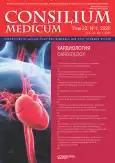Background. The working conditions of the railway staff are very hard; combine many cardiovascular disease risk factors, most often including arterial hypertension (AH). Aim. Research was to study heart rhythm disorders and total cardiovascular risk among members of locomotive crews with arterial hypertension. Materials and methods. The study included 106 railway employees (train drivers and assistant drivers) aged 47-63 years (53 employees with AH and 53 employees without AH). All patients passed through 12-channel daily ECG monitoring. There were evaluated heart rhythm disorders (ventricular and supraventricular), non-invasive predictors and markers of electrical myocardial instability (circadian profile, QT interval, ventricular late potentials, T-wave alternation, rhythm variability). To assess the total cardiovascular risk, the SCORE system was performed to calculate the risk of death due to cardiovascular incidents within the next 10 years, body mass index, blood glucose and total cholesterol, office blood pressure, as well as the presence of bad habits, such as smoking and alcohol intake. In addition to the traditional ones, we took into account professional (seniority) and psychosocial (level of situational and personal anxiety by the Spielberger-Hanin) factors of cardiovascular risk. Results. The study showed significant differences in cardiac rhythm disturbances between the two groups; ventricular rhythm disturbances in the form of ventricular tachycardia were registered only in group of railway employees with AH. There were identified markers of myocardial heterogeneity in patients with AH, namely, the indicators of ventricular TotQRSF and LAS40 predictors are higher, and RMS40 is significantly lower in this group. Blood pressure levels and body mass index were established as the most significant cardiovascular risk factors for this kind of occupation. It was also revealed a reliable relationship between seniority and the risk of death on the SCORE scale, as well as blood pressure, circadian profile and heart rate variability, the frequency of registration of paired polymorphic ventricular extrasystoles according to 12-channel daily ECG monitoring in locomotive team workers in both groups. Conclusion. The presence of arterial hypertension in locomotive crew employees is associated with a higher frequency of supraventricular rhythm disturbances and a higher risk of ventricular rhythm disturbances than in employees without arterial hypertension. Members of locomotive crews have moderate total cardiovascular risk, while individuals with arterial hypertension have higher body mass index values. In both examined groups, the seniority is directly related to both cardiovascular risk factors (blood pressure level, body mass index, risk of death within the next 10 years on the SCORE scale), as well as indicators of the circadian index and heart rate variability, ventricular rhythm disturbances according to daily ECG monitoring.
 9-13
9-13


 14-18
14-18


 19-25
19-25


 26-30
26-30


 31-37
31-37


 38-43
38-43


 44-48
44-48


 49-53
49-53


 54-60
54-60


 61-66
61-66


 67-71
67-71







